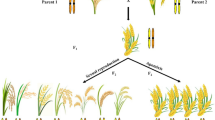Abstract.
A new cytoplasmic male sterility (CMS) source in Brassica juncea (2n = 36; AABB) was developed by substituting its nucleus into the cytoplasm of Enarthrocarpus lyratus (2n = 20; EℓEℓ). Male sterility was complete, stable and manifested in either petaloid- or rudimentary-anthers which were devoid of fertile pollen grains. Male sterile plants resembled the euplasmic B. juncea except for slight leaf yellowing and delayed maturity. Leaf yellowing was due mainly to higher level of carotenoids rather than a reduction in chlorophyll pigments. Female fertility in male-sterile plants varied; it was normal in lines having rudimentary anthers but poor in those with petaloid anthers. Each of the 62 evaluated germplasm lines of B. juncea was a functional maintainer of male sterility. The gene(s) for male-fertility restoration (Rf) were introgressed from the cytoplasm donor species through homoeologous pairing between A and Eℓ chromosomes in monosomic addition plants (2n = 18II+1Eℓ). The percent pollen fertility of restored F1 (lyr CMS × putative restorer) plants ranged from 60 to 80%. This, however, was sufficient to ensure complete seed set upon by bag selfing. The CMS (lyr) B. juncea compared favourably with the existing CMS systems for various productivity related characteristics. However, the reduced transmission frequency of the Rf gene(s) through pollen grains, which was evident from the sporadic occurrence of male-sterile plants in restored F1 hybrids, remains a limitation.



Similar content being viewed by others
References
Banga SS (2001) Towards commercial hybrids in mustard [Brassica juncea (L) Coss]. In: Liu H, Fu TD (eds) Proc Int Symp Rapeseed Sci, Science Press, New York, pp 35–40
Bannerot H, Boulidard L, Chupeau Y (1977) Unexpected difficulties met with the radish cytoplasm in Brassica oleracea. Cruciferae Newslett 2:16
Deol JS, Shivanna KR, Prakash S, Banga SS (2003) Enarthrocarpus lyratus-based cytoplasmic male sterility and fertility restorer system in Brassica rapa. Plant Breed (in press)
Fu TD, Yang GS (1998) Rapeseed-mustard. In: Banga SS, Banga SK (eds) Hybrid cultivar development, Co-Publication Springer-Verlag-Germany and Narosa Publishing House-New Delhi, pp 402–431
Heyn FW (1976) Transfer of the restorer gene from Raphanus to cytoplasmic male-sterile Brassica napus. Cruciferae Newlett 1:15–16
Hinata K, Konno N (1979) Studies on a male-sterile strain with a Brassica campestris nucleus and Diplotaxis muralis cytoplasm. The breeding process and some characteristics of the strain. Jpn J Breed 29:305–311
Gundimeda HR, Prakash S, Shivanna KR (1992) Intergeneric hybrids between Enarthrocarpus lyratus, a wild species, and crop brassicas. Theor Appl Genet 83:655–662
Kirti PB, Banga SS, Prakash S, Chopra VL (1995) Transfer of ogu cytoplasmic male sterility to Brassica juncea and improvement of the male sterile through somatic cell fusion. Theor Appl Genet 91:517–521
Mukai Y, Tsunewaki K (1976) Genetic diversity of cytoplasm in Triticum and Aegilops. IV. Distribution of the cytoplasm inducing variegation in common wheat. Theor Appl Genet 48:9–16
Pearson OH (1972) Cytoplasmically inherited male-sterility characters and flavour components from the species cross Brassica nigra (L.) Koch ×B. oleracea L. J Am Soc Hort Sci 97:398–402
Prakash S (2001) Utilization of wild germplasm of Brassica allies in developing cytoplasmic male sterility/fertility restoration systems in Indian mustard – Brassica juncea. In: Liu H, Fu TD (eds) Proc Int Symp Rapeseed Sci, Science Press, New York, pp 63–68
Prakash S, Kirti PB, Chopra VL (1998a) Development of cytoplasmic male sterility/fertility restoration systems of variable origin in mustard – Brassica juncea. Acta Hort 459:299–304
Prakash S, Kirti PB, Bhat K, Gaikwad V, Dinesh Kumar, Chopra VL (1998b) Moricandia arvensis-based cytoplasmic male sterility and the fertility restoration system in Brassica juncea. Theor Appl Genet 97:488-492
Prakash S, Ahuja I, Upreti HC, Dinesh Kumar V, Bhat SR, Kirti PB, Chopra VL (2001) Expression of male sterility in alloplasmic Brassica juncea with Erucastrum canariense cytoplasm and the development of a fertility restorer system. Plant Breed 120:1–5
Röbbelen G (1960) Beitrage zur Analyse des Brassica – genomes. Chromosoma 11:205–228
Vernon LP (1960) Spectrophotometric determination of chlorophyll and pheophytins in plant extracts. Anal Chem 32:144–150
Author information
Authors and Affiliations
Corresponding author
Additional information
Communicated by K. Glimelius
Rights and permissions
About this article
Cite this article
Banga, S.S., Deol, J.S. & Banga, S.K. Alloplasmic male-sterile Brassica juncea with Enarthrocarpus lyratus cytoplasm and the introgression of gene(s) for fertility restoration from cytoplasm donor species. Theor Appl Genet 106, 1390–1395 (2003). https://doi.org/10.1007/s00122-002-1180-1
Received:
Accepted:
Published:
Issue Date:
DOI: https://doi.org/10.1007/s00122-002-1180-1




